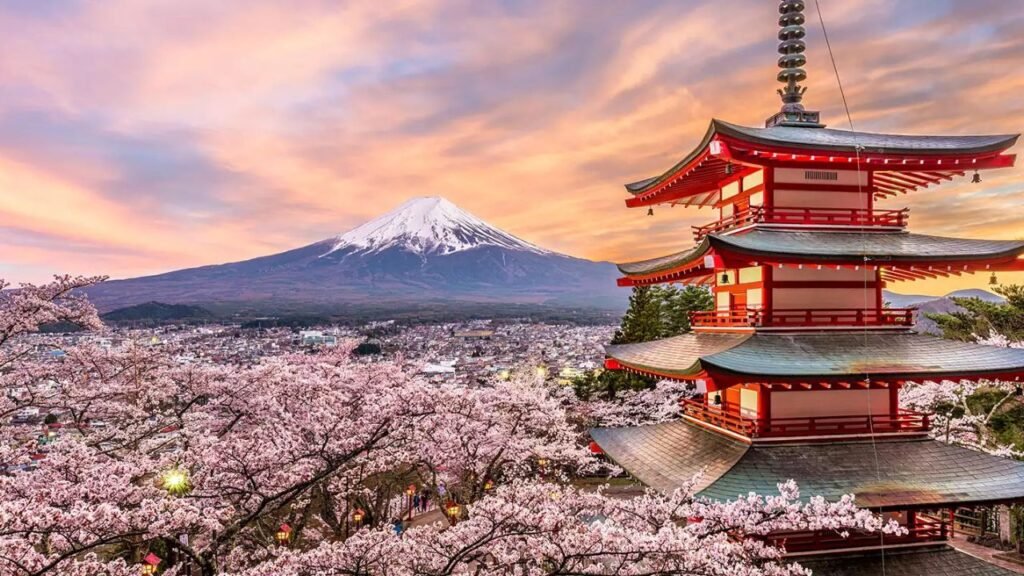Introduction
Embarking on a journey to Japan, a country where ancient traditions harmoniously blend with cutting-edge modernity, was a dream I cherished for years. From the bustling streets of Tokyo to the tranquil temples of Kyoto, the scenic beauty of Mount Fuji to the vibrant cultural festivals, every moment of my trip was a tapestry woven with discovery, awe, and profound appreciation. This essay narrates my comprehensive experience exploring Japan, capturing the essence of its landscapes, people, cuisine, and traditions.
Planning and Preparation
The excitement began months before my departure. I immersed myself in researching Japan’s regions, cultural norms, transportation systems, and language basics. Learning simple phrases in Japanese, understanding etiquette like bowing and removing shoes indoors, and planning an itinerary that balanced city explorations with serene retreats were essential steps.
Booking accommodations ranged from traditional ryokans (inns) with tatami mats and futons to modern hotels. I purchased a Japan Rail Pass, which proved invaluable for efficient travel across cities. Packing involved essentials like comfortable walking shoes, a universal power adapter, a compact umbrella, and traditional kimonos for special occasions.
Arrival in Tokyo: The City of Contrasts
My journey began in Tokyo, a metropolis that epitomizes juxtaposition. Upon landing at Narita International Airport, the first thing that struck me was the seamless blend of the ultra-modern and the traditional. The towering skyline with skyscrapers like the Tokyo Skytree and Mode Gakuen Cocoon Tower contrasted sharply with historic temples nestled amidst urban sprawl.
First Impressions and Transportation
Navigating Tokyo’s sophisticated subway system was an adventure in itself. The trains are punctual to a fault, spotless, and an efficient way to traverse the city. I was greeted by the hum of activity—clad in fashionable attire, people rushing to work, and neon signs illuminating the night sky.
Cultural Landmarks and Neighborhoods
I started my exploration in Asakusa, home to Senso-ji, Tokyo’s oldest temple. Walking through Nakamise-dori, a bustling street lined with shops selling traditional snacks, souvenirs, and kimono rentals, I felt immersed in history. The vibrant red gate, Kaminari-mon, welcomed me into a realm where ancient spirituality coexists with modern commerce.
Next, I visited Shibuya, famous for the iconic scramble crossing. Standing amidst hundreds of people crossing from all directions simultaneously was surreal. The energy was contagious, and I took countless photos of the neon-lit streets.
Culinary Delights
Tokyo’s culinary scene is a paradise for food lovers. I savored fresh sushi at Tsukiji Market, indulged in ramen from tiny stalls in Shinjuku, and sampled tempura in a cozy neighborhood restaurant. Every dish was a celebration of freshness and craftsmanship. The meticulous presentation and harmonious flavors reflected Japan’s dedication to perfection.
Cultural Experiences
I also attended a traditional tea ceremony, where I learned about the precise rituals involved in preparing and serving matcha. Participating in calligraphy sessions allowed me to appreciate the patience and skill required to master this art form. Visiting a sumo stable, I witnessed wrestlers’ rigorous training routines, gaining insight into Japan’s national sport.
Exploring Nature and Traditional Kyoto
After a few days in Tokyo, I headed to Kyoto, the cultural heart of Japan. The shinkansen (bullet train) ride was swift and comfortable, whisking me through scenic landscapes of mountains, rice paddies, and quaint villages.
Historical and Cultural Sites
Kyoto boasts over a thousand temples, shrines, and historic sites. My first stop was Fushimi Inari Taisha, renowned for its thousands of vermilion torii gates winding up the mountain. Walking through this seemingly endless tunnel of gates was an ethereal experience, evoking a sense of spiritual reverence.
I visited Kinkaku-ji, the Golden Pavilion, whose shimmering gold leaf exterior reflected beautifully in the mirror-like pond. The meticulous Japanese gardens surrounding the temple exuded tranquility. Nearby, Ryoan-ji’s rock garden was a minimalist masterpiece, inviting contemplation.
Traditional Geisha Districts
Gion, Kyoto’s famous geisha district, transported me back in time. Strolling along narrow stone-paved streets lined with traditional machiya houses, I glimpsed maiko (apprentice geisha) in colorful kimonos. Attending a geisha performance at a teahouse was a highlight, where delicate dance, music, and poetry revealed refined artistry.
Nature’s Serenity
I hiked through the Arashiyama Bamboo Grove, where towering bamboo stalks swayed gently, creating a surreal corridor. The nearby Iwatayama Monkey Park offered playful macaques and panoramic views of Kyoto. Visiting the Philosopher’s Path during cherry blossom season was breathtaking, with sakura blossoms creating a pink canopy over the canal.
Culinary Experiences in Kyoto
Kyoto’s cuisine emphasizes seasonal ingredients and delicate flavors. I enjoyed kaiseki, a multi-course traditional meal that showcased artful presentation and harmony. Matcha-flavored sweets, yudofu (tofu hot pot), and Kyoto-style sushi enriched my palate.
The Mystique of Mount Fuji and Hakone
Next, I traveled to Hakone, renowned for its hot springs and views of Mount Fuji, Japan’s iconic snow-capped volcano.
Mount Fuji’s Majesty
On a clear day, I took a bus and cable car to the Fuji Subaru Line 5th Station, where I marveled at the panoramic vista of the mountain’s symmetrical cone. The air was crisp, and the landscape was dotted with alpine flora. I felt humbled by nature’s grandeur.
Relaxing in Onsen
After a day of exploring, I relaxed in an onsen (hot spring) ryokan. Soaking in mineral-rich waters while gazing at the surrounding mountains was soothing and rejuvenating. The experience was enhanced by traditional tatami rooms, kaiseki dinner, and the warm hospitality of the staff.
Hiroshima and Miyajima: A Reflection on History
My journey continued to Hiroshima, a city symbolizing resilience and peace.
Hiroshima Peace Memorial Park
Visiting the Peace Memorial Park was a poignant experience. The Atomic Bomb Dome stood as a haunting reminder of the devastation, while the Peace Memorial Museum presented harrowing stories and artifacts. Reflecting on humanity’s capacity for destruction strengthened my resolve for peace.
Miyajima Island and Its Torii
A short ferry ride took me to Miyajima, famous for Itsukushima Shrine’s floating torii gate. The gate appeared to hover on the water during high tide, creating a mystical sight. Exploring the island’s lush forests and friendly deer added to the serenity.
The Cultural Festivals and Nightlife
Throughout my trip, I encountered various festivals and lively events.
Matsuri Celebrations
In Kyoto, I participated in Gion Matsuri, a centuries-old festival featuring colorful floats, traditional music, and street food. The festive atmosphere was infectious, and I enjoyed wearing a yukata (summer kimono).
Tokyo’s Nightlife
Tokyo’s nightlife offered vibrant entertainment. I visited jazz clubs, karaoke bars, and izakayas (pubs), bonding with locals over sake and shared stories. The city’s energy at night was intoxicating.
Personal Reflections and Cultural Insights
Traveling through Japan was more than sightseeing; it was an immersive voyage into a culture rooted in respect, harmony, and craftsmanship.
Respect for Tradition and Nature
I learned that the Japanese place great importance on etiquette, humility, and harmony with nature. From bowing to elders to removing shoes indoors, these customs foster mutual respect.
The Art of Wabi-Sabi
The aesthetic concept of wabi-sabi, embracing imperfection and transience, was evident in their architecture, gardens, and arts. It reminded me to appreciate the fleeting beauty of life.
Technological Innovation and Preservation
Japan’s seamless integration of technology with tradition fascinated me. Robots in service roles coexisted with centuries-old temples, illustrating a society that values both progress and preservation.
Humility and Hospitality
The warmth and politeness of the Japanese people left a lasting impression. Their genuine hospitality made me feel welcomed and valued as a guest.
Challenges and Lessons Learned
While Japan’s beauty and culture enchanted me, I faced challenges such as language barriers and navigating complex transit systems. These obstacles taught me patience, adaptability, and the importance of preparation.
Conclusion: A Journey of Transformation
My Japanese tour was a transformative experience that expanded my horizons, deepened my cultural understanding, and rekindled my appreciation for the simple and profound aspects of life. From the vibrant cityscapes to tranquil temples, from culinary delights to heartfelt conversations, Japan’s multifaceted charm left an indelible mark on my soul.
This journey reaffirmed that travel is not just about sightseeing but about connecting with a culture, embracing new perspectives, and discovering oneself amidst unfamiliar landscapes. I return home enriched, inspired, and eager to share the stories of my unforgettable adventure in Japan




